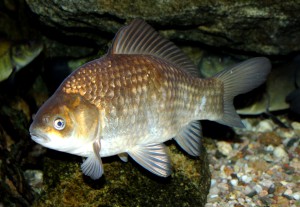 This carp differs from the silver Prussian carp by fewer gill rakers on the mandible (23-33 with crucian, and 39-50 with the Prussian). The back in the crucian is usually dark brown with a greenish tinge; the flanks are dark golden, with occasional copper sheen; the paired fins are somewhat reddish. It is found in Central and Eastern Europe, as well as in Siberia till the Lena. Crucian live in swamped and overgrown waters and flooded lakes; it is rare in rivers, sticking to sluggish stretches. They are characterized by a peculiar attachment to the waters on muddy beds. In the winter, crucian dig up in soil and survive even in the cold spells when the water body freezes through. Similar endurance is displayed in summer droughts, when lakes and bogs they live in completely dry out. They can bury themselves in mud 70 cm deep. Possibly, this is the explanation of the wondrous occurrence of crucian in dried out lakes of North Kazakhstan after they were re-filled with water. Owing to the outstanding resistance to unfavorable factors compared to other fish species, crucian often happen to be the only fish in the water. They present considerable variability depending on the environment. In strongly swamped waters with low nutrition it morphs into a deeper bodied big-headed and slow-growing dwarf form maturing early, and in waters favorable they grow fast and disc-shaped. They mature in their 4th year, with males maturing sooner than females. Spawning begins at temperatures above 14°С. The roe is sticky, laid into submerged plants. Spawning is intermittent. Fertility is high – up to 300 thousand eggs. They spawn quite noisily in groups. Usually females keep to the bottom, with males reeling and splashing at the surface. As soon as the females start laying roe, the males turn on their sides and milt. Spawning takes 2-3 days. The roe develops on the plants females glue it to. Fry feed on plankton, whereas the diet of adults consists of vegetative and animal organisms, as well as detritus. Growth rates differ from water to water. In favorable conditions it is quite high, and they are bred in the ponds of northern regions, where carps cannot adapt. They reach up to 45 cm and weigh 3 kilos. But usually crucian of 500-600 gr are considered to be high quality.
This carp differs from the silver Prussian carp by fewer gill rakers on the mandible (23-33 with crucian, and 39-50 with the Prussian). The back in the crucian is usually dark brown with a greenish tinge; the flanks are dark golden, with occasional copper sheen; the paired fins are somewhat reddish. It is found in Central and Eastern Europe, as well as in Siberia till the Lena. Crucian live in swamped and overgrown waters and flooded lakes; it is rare in rivers, sticking to sluggish stretches. They are characterized by a peculiar attachment to the waters on muddy beds. In the winter, crucian dig up in soil and survive even in the cold spells when the water body freezes through. Similar endurance is displayed in summer droughts, when lakes and bogs they live in completely dry out. They can bury themselves in mud 70 cm deep. Possibly, this is the explanation of the wondrous occurrence of crucian in dried out lakes of North Kazakhstan after they were re-filled with water. Owing to the outstanding resistance to unfavorable factors compared to other fish species, crucian often happen to be the only fish in the water. They present considerable variability depending on the environment. In strongly swamped waters with low nutrition it morphs into a deeper bodied big-headed and slow-growing dwarf form maturing early, and in waters favorable they grow fast and disc-shaped. They mature in their 4th year, with males maturing sooner than females. Spawning begins at temperatures above 14°С. The roe is sticky, laid into submerged plants. Spawning is intermittent. Fertility is high – up to 300 thousand eggs. They spawn quite noisily in groups. Usually females keep to the bottom, with males reeling and splashing at the surface. As soon as the females start laying roe, the males turn on their sides and milt. Spawning takes 2-3 days. The roe develops on the plants females glue it to. Fry feed on plankton, whereas the diet of adults consists of vegetative and animal organisms, as well as detritus. Growth rates differ from water to water. In favorable conditions it is quite high, and they are bred in the ponds of northern regions, where carps cannot adapt. They reach up to 45 cm and weigh 3 kilos. But usually crucian of 500-600 gr are considered to be high quality.
/ * The photos at lake.peipsi.org are cross-posted from commons.wikimedia.org and are used for familiarization purposes only. No commercial use of the photos is allowed. For more information about to use the photos see the originals on commons.wikimedia.org. /


